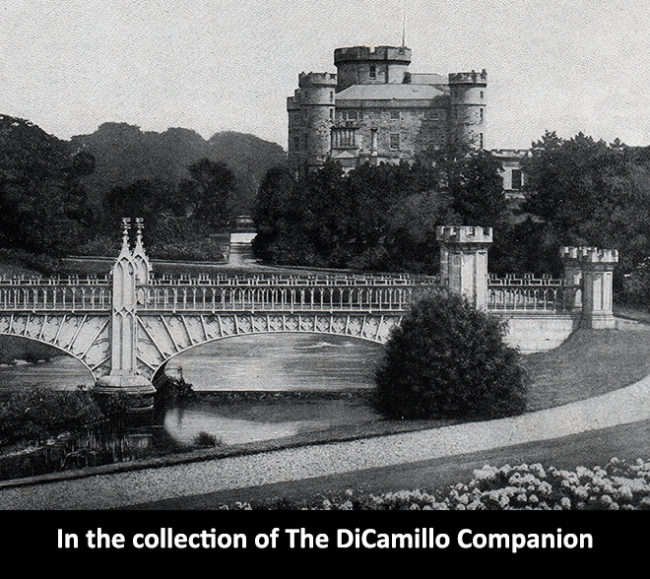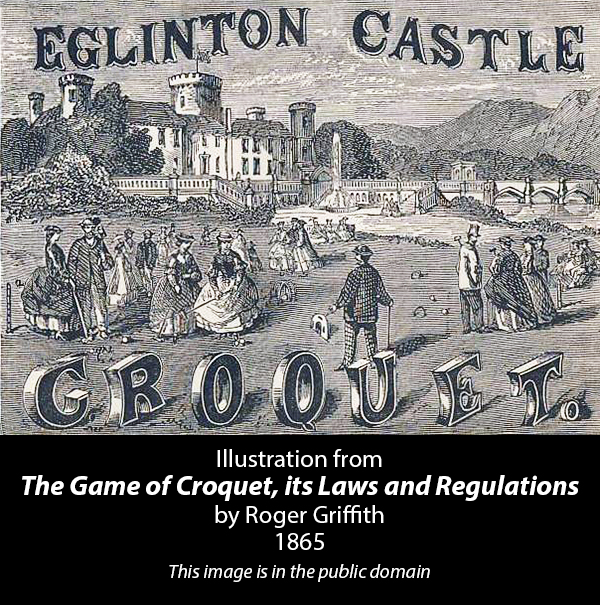
A photo of the house from the Mar 12, 1898 issue of "The Illustrated London News"

Earlier Houses: There was an earlier Eglinton Castle that was burned by the 3rd Earl of Glencairn in 1528 and replaced by a later house, elements of which were incorporated into the current house.
House & Family History: By the early 20th century the Montgomerie family had been financially ground down by death duties and expensive repairs to the castle. In 1925 the family auctioned the contents and abandoned Eglinton Castle; in 1926 the enormous castle was de-roofed and left to rot. During World War II Eglinton was seriously damaged by the British Army, who used the castle grounds for training. Much of the remaining parts of the castle, which were substantial, were further demolished in the 1970s. One main tower, together with some of the castle's outer walls, foundations, and parts of the wings were shored up and preserved in 1973 as a stabilized ruin. The Wilson family, who purchased the Eglinton Estate in 1950, donated the land and castle ruins to Cunninghame District Council in 1978 for use as a public park. Its successor body, North Ayrshire Council, today owns and operates Eglinton Country Park, which hosts over 250,000 visitors a year.
Collections: Among other treasures, Eglinton Castle contained a chair built from oak timbers of Alloway Kirk; the back of the chair had Robert Burns's poem "Tam O' Shanter" inlaid on a brass plaque. In December of 1925 Dowell's Ltd. auctioned the contents of Eglinton, 1,960 lots, including the Alloway Kirk chair.
Garden & Outbuildings: The 14th Earl of Eglinton, who was obsessed with the game of croquet, built a grand croquet lawn between the castle and Lugton Water in the mid-19th century. In 1865 the earl commissioned the publication of "The Game of Croquet, its Laws and Regulations." Written by Roger Griffith, it is the earliest known reference to croquet in Scotland; rather appropriately, the page facing the title page shows an image of Eglinton Castle in the background with a game of croquet in progress in the foreground (see "Images" section). However, Eglinton is best remembered today for the lavish Eglinton Tournament, a medieval-style tournament inspired by Walter Scott's novel "Ivanhoe" and organized in August of 1839 by the 13th Earl of Eglinton. Participants, like Prince Louis-Napoleon Bonaparte (the future Emperor Napoleon III), took up full medieval dress and participated in events such jousting. The tournament attracted 100,000 spectators and was hugely influential in the revival of Gothic Romanticism. Its success laid the groundwork for the Tournament of Brussels in 1905 and the historical reenactments of the 20th and 21st centuries. The earl's granddaughter, Viva Montgomerie, recalled in her memoirs that he had "spent most of the wealth of the estate" on the tournament, a financial wound from which Eglinton never recovered and which led to its sale and dismemberment in 1925. In 1963 Ian Anstruther wrote a book on the tournament entitled "The Knight and the Umbrella: An Account of the Eglinton Tournament 1839." The 9th Earl of Eglinton was extraordinarily taken by the beauty of Susanna, his third wife; and built for her on the Eglinton Estate a copy of Marie Antoinette's Hameau de la Reine from the Petit Trianon at Versailles. This cottage orné still stands and is today a golf clubhouse.
Architect: William Adam Sr.
Date: Probably early 18th centuryArchitect: David Hamilton
Date: 1811Architect: John Paterson
Date: 1797-1803Vitruvius Scoticus: Adam, W., pl. 123 [Temple], 1810.
John Bernard (J.B.) Burke, published under the title of A Visitation of the Seats and Arms of the Noblemen and Gentlemen of Great Britain and Ireland, among other titles: Vol. II, p. 36, 1853.
Title: Biographical Dictionary of British Architects, 1600-1840, A - HARDBACK
Author: Colvin, Howard
Year Published: 2008
Reference: pgs. 59, 110, 472, 786
Publisher: New Haven: Yale University Press
ISBN: 9780300125085
Book Type: Hardback
House Listed: Category C
Park Listed: Listed as a Garden & Designed Landscape
Past Seat / Home of: SEATED AT EARLIER HOUSES: Alexander Montgomerie, 9th Earl of Eglinton, until 1729; Alexander Montgomerie, 10th Earl of Eglinton, 1729-69; Archibald Montgomerie, 11th Earl of Eglinton, 1769-96. SEATED AT CURRENT HOUSE: Colonel Hugh Montgomerie, 12th Earl of Eglinton, 1797-1819; Archibald William Montgomerie, 13th Earl of Eglinton and 1st Earl of Winton, 1819-61; Archibald William Montgomerie, 14th Earl of Eglinton and 2nd Earl of Winton, 1861-92; George Arnulph Montgomerie, 15th Earl of Eglinton and 3rd Earl of Winton, 1892-1919; Archibald Seton Montgomerie, 16th Earl of Eglinton and 4th Earl of Winton, 1919-25; Montgomerie family here from the 17th century until 1925.
Current Ownership Type: Government
Primary Current Ownership Use: Public Park
Ownership Details: Since 1978 Eglinton Country Park, owned and operated by North Ayrshire Council.
House Open to Public: Grounds Only
Phone: 01294-551-776
Fax: 01294-556-467
Email: [email protected]
Website: https://www.north-ayrshire.gov.uk
Historic Houses Member: No